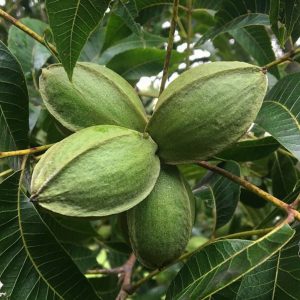Pecans were a useful food source of Native Americans for thousands of years before European explorers came to America. The nuts were disseminated from the Mississippi Valley eastward by Native Americans. Pecans were readily available, easier to shell than other North American nut species, and they had great taste. Pecans soon became a popular trade item with Native Americans and settlers. For these reasons, they quickly gained significance in the Southeast.
Although historically important, the pecan has only been cultivated for a short period of time. Originally, pecans were derived from seedling pecan trees until about 150 years ago. At that time, grafted cultivars became important for higher quality, increased yields and overall better production. Then, trees with optimal characteristics were identified, named and propagated for cultivation. Over the past several decades, scientists have utilized breeding programs to establish new high yielding cultivars with desirable characteristics. As a result of these programs, there are over 500 different pecan cultivars, all with unique traits. The production of the crop in Florida is around five to ten million pounds of pecans annually. Almost all of this commercial production is in the Panhandle and North-central Florida.
Even though it’s easy for local producers to look forward to the harvest and baking their holiday pecan pies, it’s important to care for the trees throughout the maturation process of the nuts. There are a few activities and management efforts that should not go over-looked throughout the fall and winter. Continuous care throughout the year will ensure healthy trees and a viable crop of pecans next year. Refer to the following checklist of items for management reminders. With the proper care and attention, trees will produce a bountiful harvest of this Southern staple – just in time for those pies!
Fall and Winter Pecan Production Checklist
October:
- Prepare for harvest by mowing, servicing equipment, removing debris including any crop remnants from last year.
- Early harvesting may begin.
- Market crop.
- Lime, zinc, phosphorus and magnesium may be applied.
- Prepare site for any new plantings.
- Apply herbicide as needed.
- Be aware of any pre-harvest intervals for all chemicals applied.
November:
- Harvest early to get the best quality and best market price.
- Don’t allow pecans to lie on the ground for an extended period.
- Lime, zinc, phosphorus and magnesium may be applied.
- Market the crop.
- Prepare site for any new plantings.
- Prevent damage to crop from wildlife.
December:
- Continue harvest and marketing of crop if not complete.
- Prune and train trees and remove debris.
- Lime, zinc, phosphorus and magnesium may be applied.
- Plant trees and thin overcrowded orchards.
- Complete a soil test.
- Service and repair equipment.
January:
- Thin overcrowded orchards and plant or move trees.
- Prune or train trees and clean up limbs and debris.
- Lime, zinc, phosphorus and magnesium may be applied.

Sources:
Anderson, P. The Pecan Tree (HS982). 2018. Gainesville: University of Florida Institute of Food and Agricultural Sciences. Retrieved from http://edis.ifas.ufl.edu/hs229
University of Georgia’s Pecan Production Calendar.
Photos by Adrienne Boyette of Boyette Pecan Company, Live Oak, Florida
UF/IFAS Extension is an Equal Opportunity Institution
 1
1
